Just as you’ve been thinking about adding elegance to your home, white orchids have become increasingly available at local garden centers. You’ll find these sophisticated bloomers offer both striking visual appeal and manageable care requirements, making them an ideal choice for both novice and experienced plant enthusiasts. Before you select your first white orchid, though, you’ll want to understand which varieties will best suit your space and lifestyle.
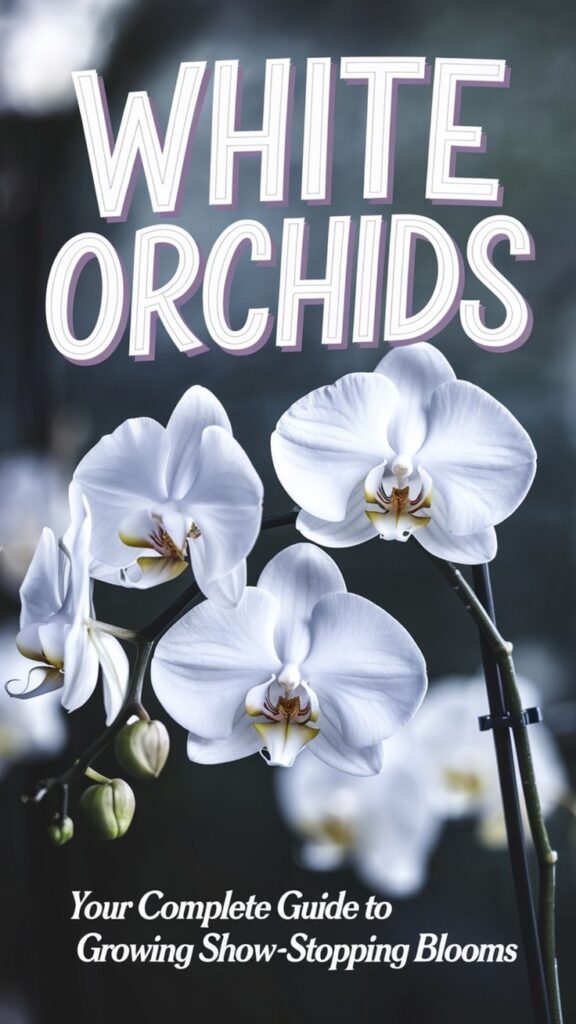
Contents
- 1 Popular Types of White Orchids for Home Display
- 1.1 Moon Orchid (Phalaenopsis amabilis)
- 1.2 Cattleya intermedia alba
- 1.3 White Egret Orchid (Habenaria radiata)
- 1.4 Dancing Lady Orchid (Oncidium Twinkle)
- 1.5 Sogo Orchid (Phalaenopsis stuartiana)
- 1.6 Phantom Orchid (Cephalanthera austiniae)
- 1.7 Pigeon Orchid (Dendrobium crumenatum)
- 1.8 White Fringed Orchid (Platanthera blephariglottis)
- 1.9 Queen’s Lady Slipper (Cypripedium reginae)
- 1.10 Tovar Masdevallia (Masdevallia tovarensis)
- 1.11 Wind Orchid (Vanda falcata)
- 1.12 Holy Ghost Orchid (Peristeria elata)
- 1.13 White Fringeless Orchid (Platanthera integrilabia)
- 1.14 Christmas Orchid (Cattleya trianae)
- 1.15 Greater Butterfly Orchid (Platanthera chlorantha)
- 1.16 Great Plains White Fringed Orchid (Platanthera praeclara)
- 1.17 Eastern Prairie Fringed Orchid (Platanthera leucophaea)
- 1.18 Bog Candle (Platanthera dilatata)
- 1.19 Snowdrop Orchid (Dendrobium infundibulum)
- 1.20 White Spider Orchid (Caladenia longicauda)
- 1.21 White Lady Orchid (Caladenia catenata)
- 1.22 White Jewel Orchid (Ludisia discolor alba)
- 1.23 White Butterfly Orchid (Platanthera bifolia)
- 1.24 White Slipper Orchid (Paphiopedilum niveum)
- 1.25 White Bog Orchid (Platanthera leucostachys)
- 1.26 White Swamp Orchid (Phaius tankervilleae alba)
- 1.27 White Rain Orchid (Cymbidium eburneum)
- 1.28 White Star Orchid (Angraecum sesquipedale)
- 2 Essential Growing Conditions for White Orchids
- 3 Watering and Feeding Your White Orchids
- 4 Creative Ways to Display White Orchids in Your Home
- 5 Common Problems and Troubleshooting Tips
- 6 Seasonal Care and Maintenance Schedule
Popular Types of White Orchids for Home Display
While many orchid varieties come in vibrant colors, white orchids offer an unmatched elegance that can transform any indoor space.
Moon Orchid (Phalaenopsis amabilis)
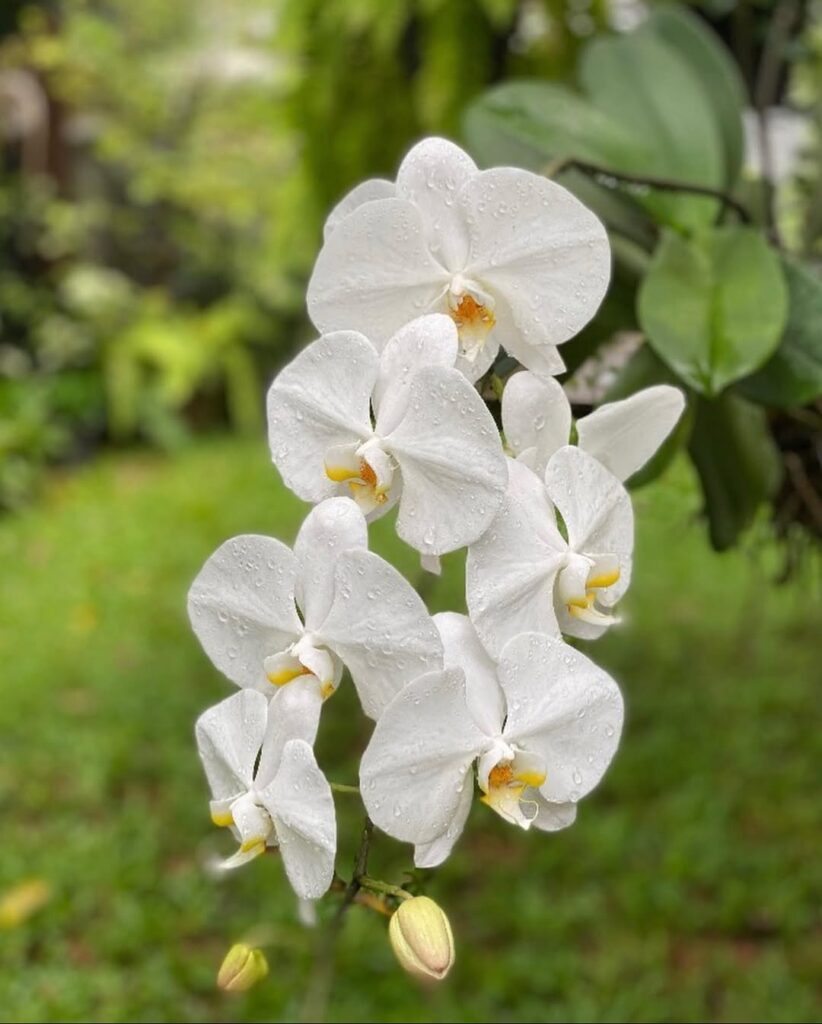
An iconic species with elegant, long-lasting white blooms that symbolize purity. Perfect for beginners due to its easy care.
Cattleya intermedia alba
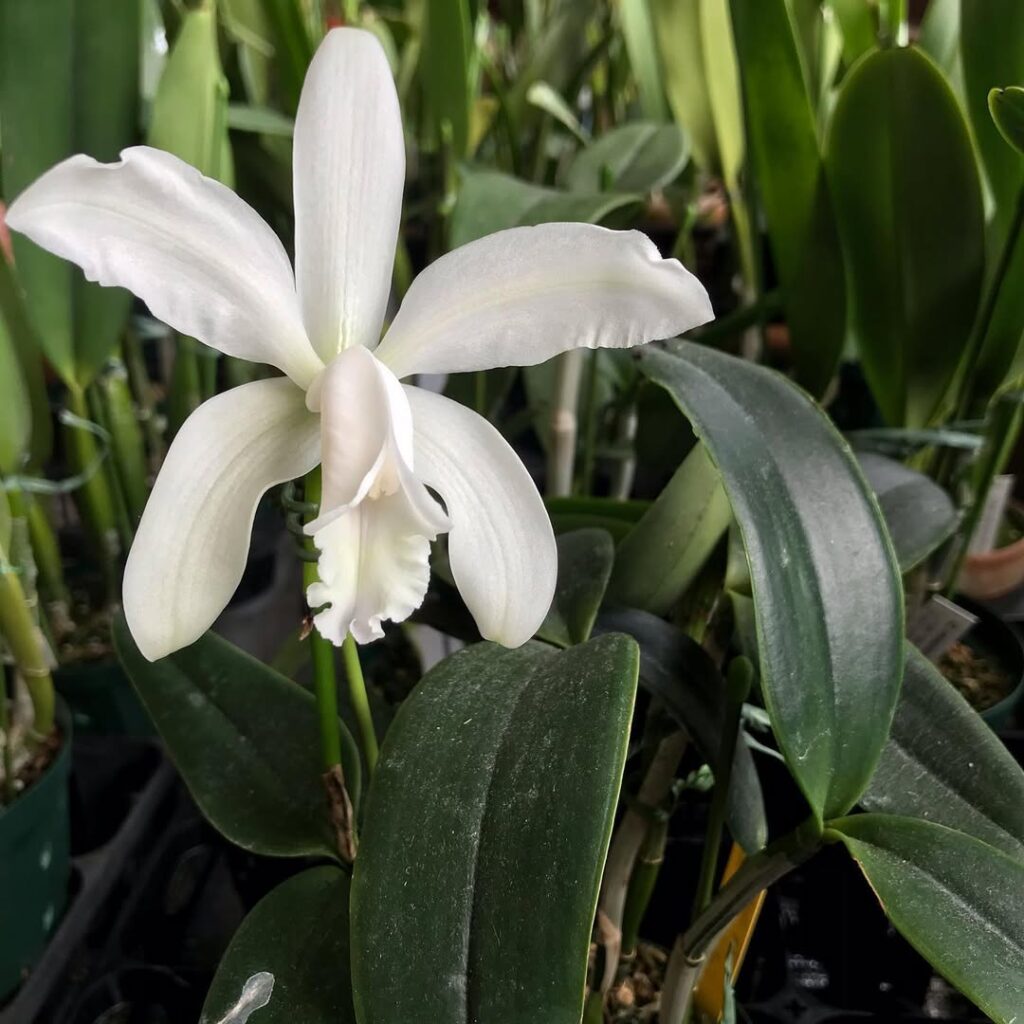
Known for its large, fragrant white flowers, this orchid exudes sophistication and beauty.
White Egret Orchid (Habenaria radiata)
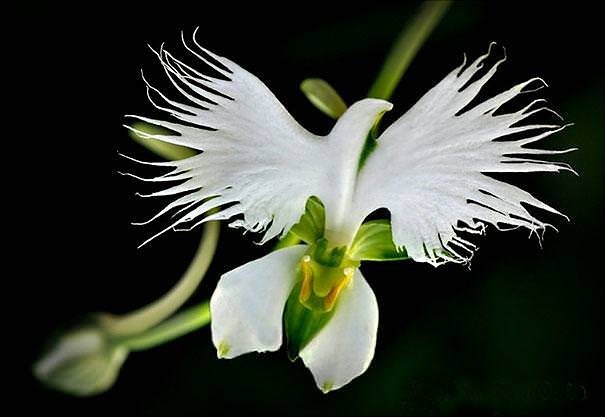
Delicate, fringed flowers resemble a white egret in flight, captivating nature lovers.
Dancing Lady Orchid (Oncidium Twinkle)
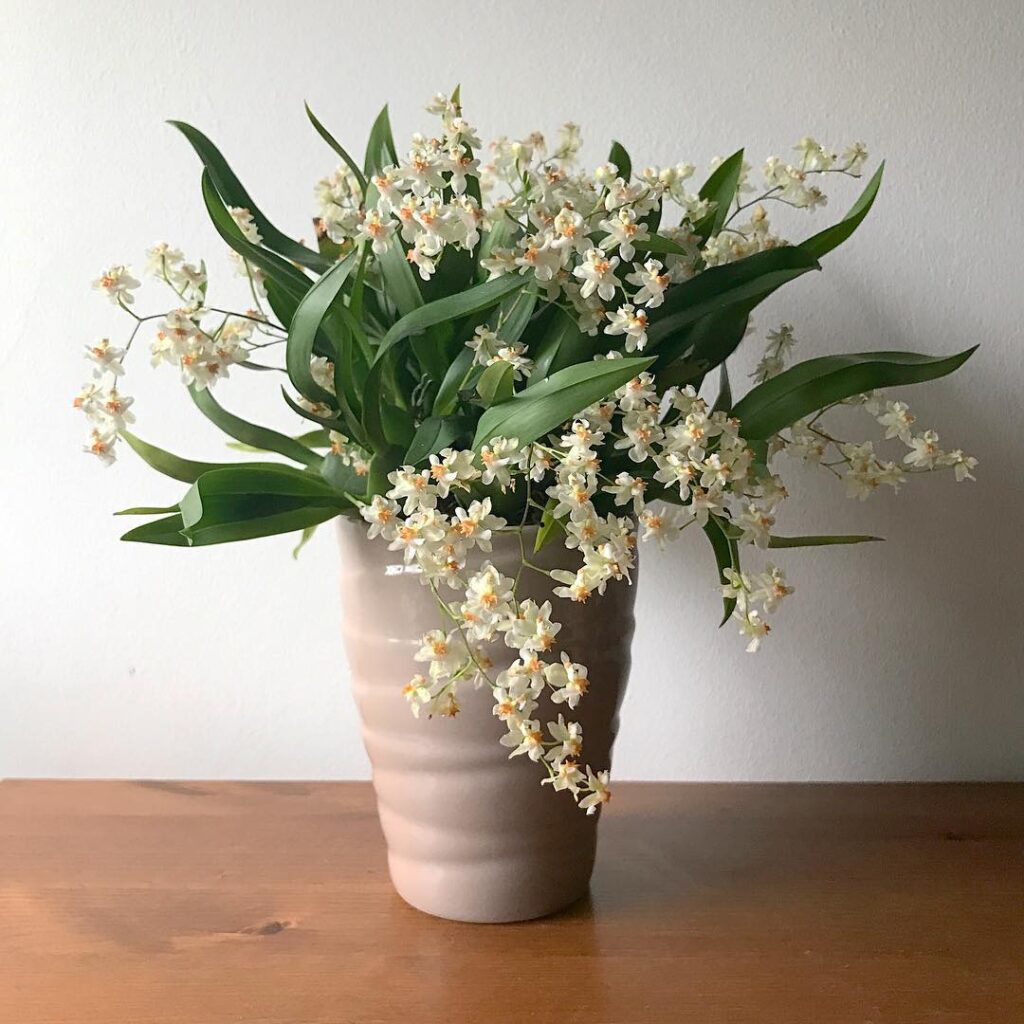
Clusters of dainty, snow-white flowers on a compact plant make it a favorite for small spaces.
Sogo Orchid (Phalaenopsis stuartiana)
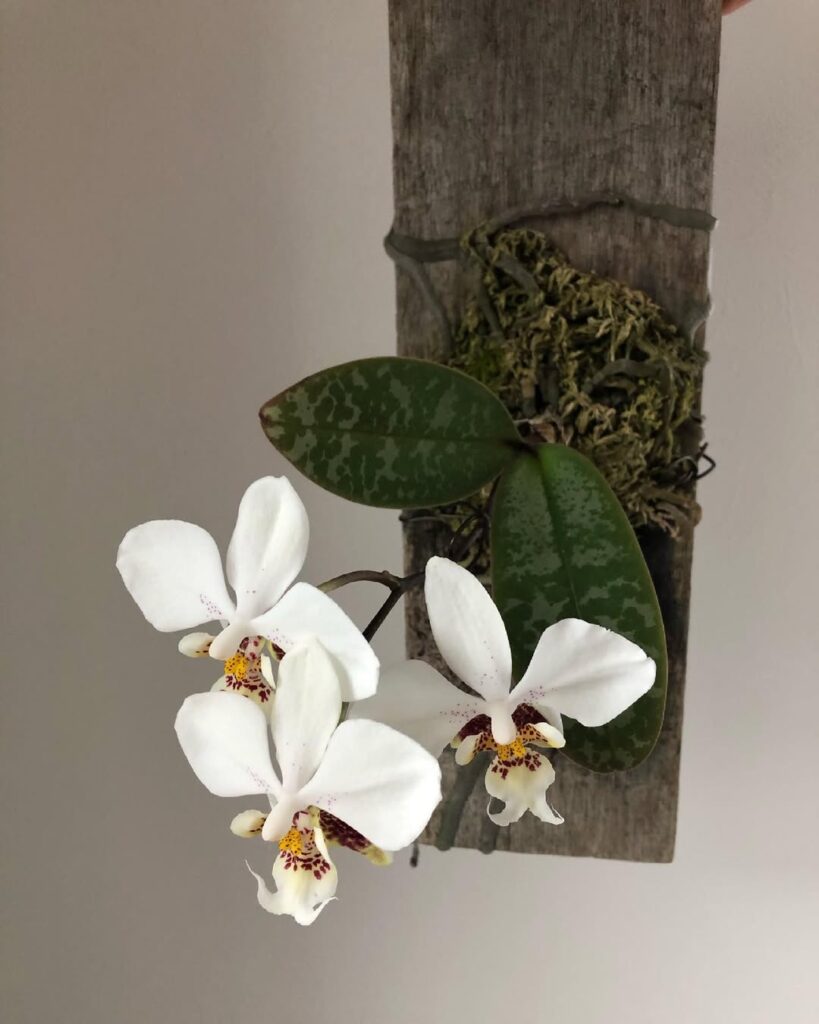
This orchid stuns with its abundant white blossoms and often features intriguing speckles.
Phantom Orchid (Cephalanthera austiniae)

A mysterious, leafless orchid thriving in forested habitats, with elegant white flowers.
Pigeon Orchid (Dendrobium crumenatum)
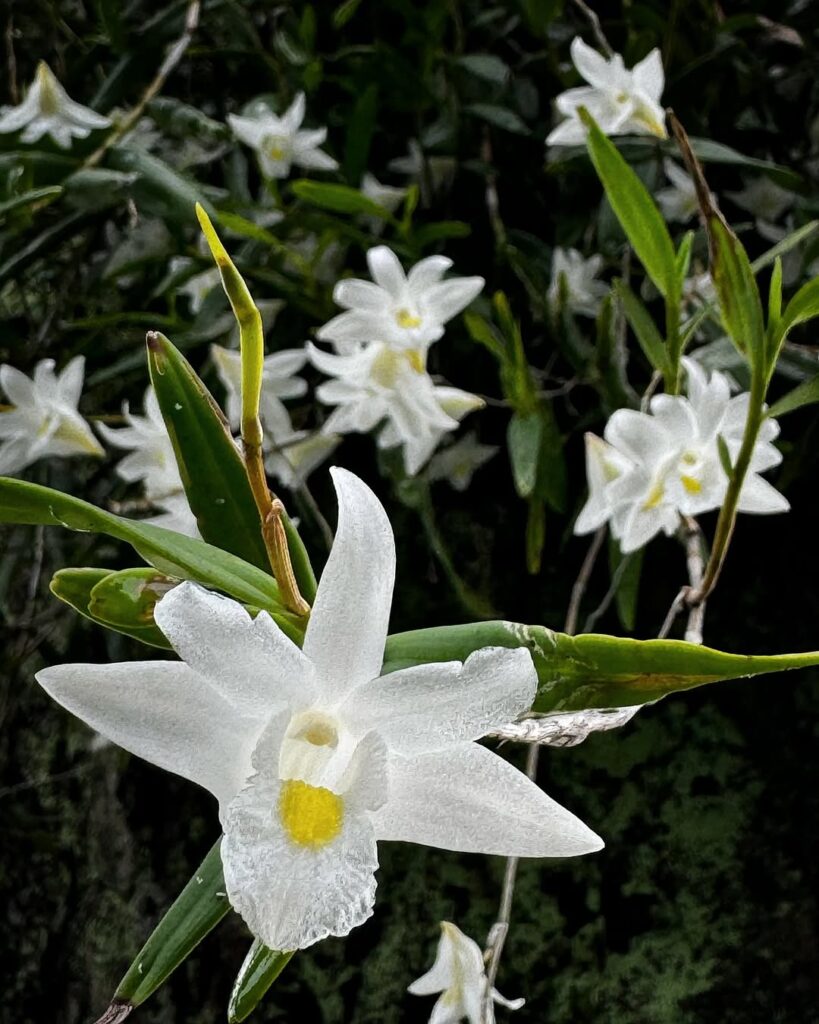
Named for its pigeon-like appearance, this orchid produces fleeting, fragrant white blooms.
White Fringed Orchid (Platanthera blephariglottis)
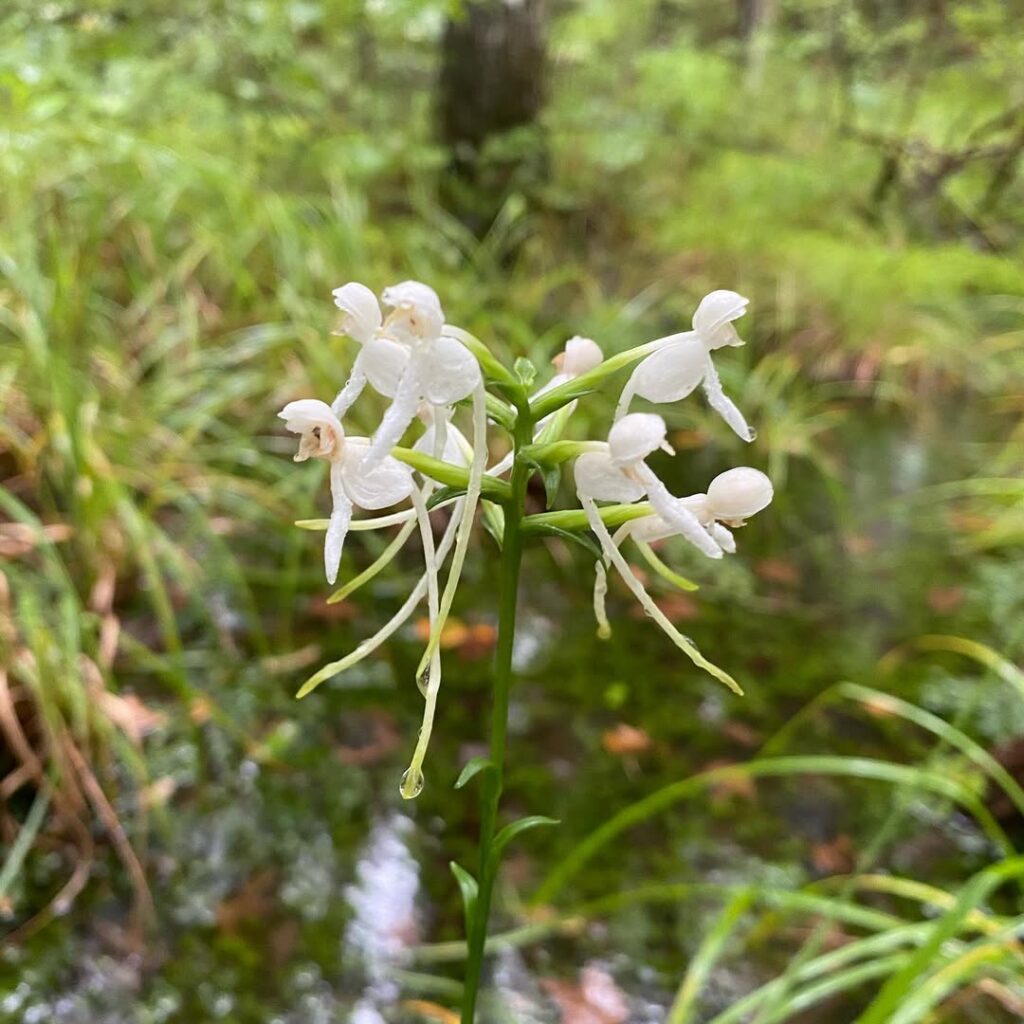
A native wild orchid, admired for its feathery white petals and boggy habitat.
Queen’s Lady Slipper (Cypripedium reginae)
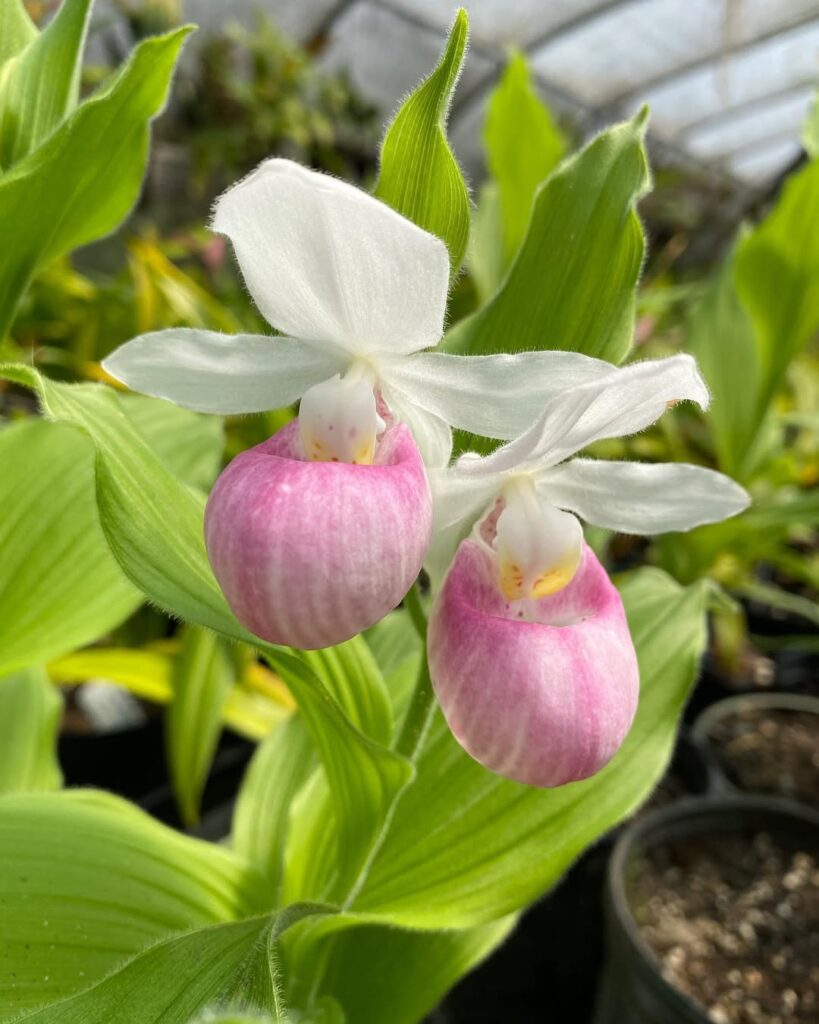
A regal species with a pristine white slipper-shaped flower often paired with pink accents.
Tovar Masdevallia (Masdevallia tovarensis)
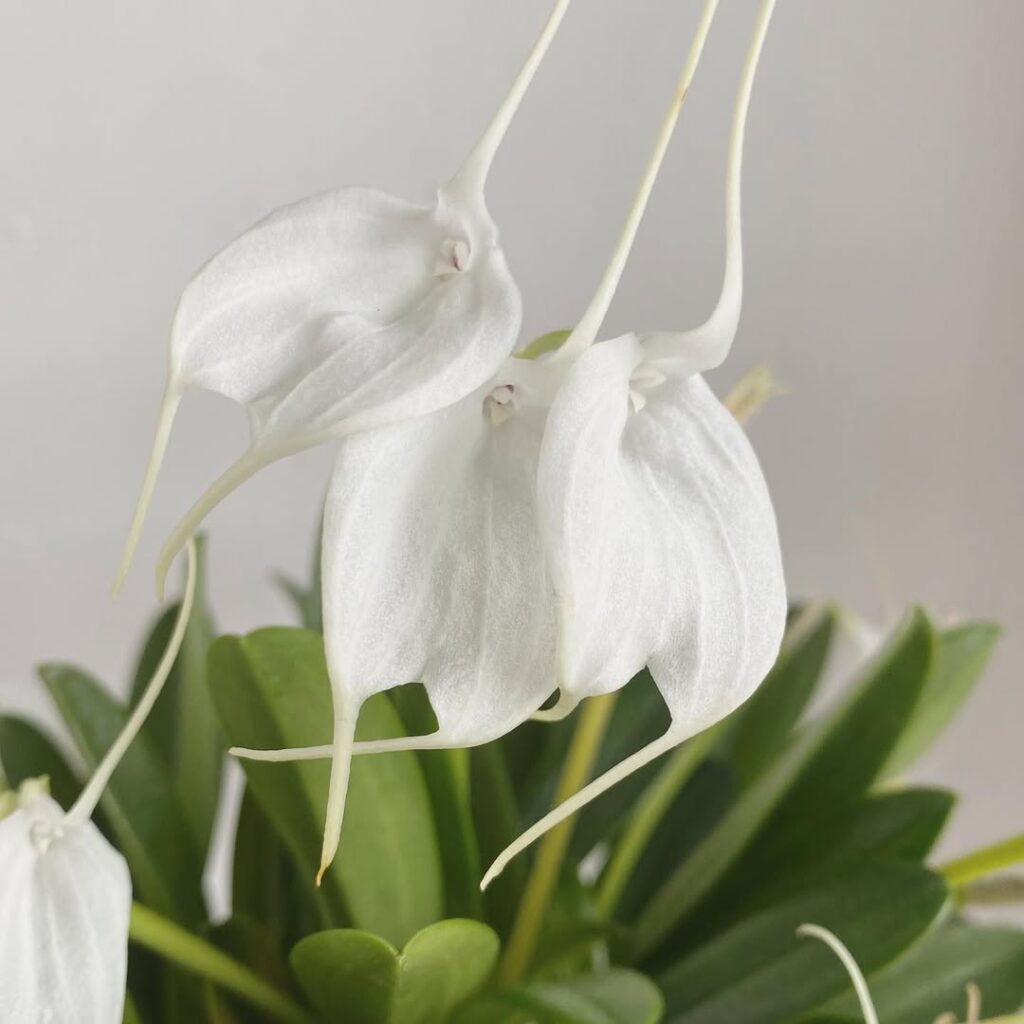
A miniature orchid with translucent white blooms that add a touch of elegance to any collection.
Wind Orchid (Vanda falcata)
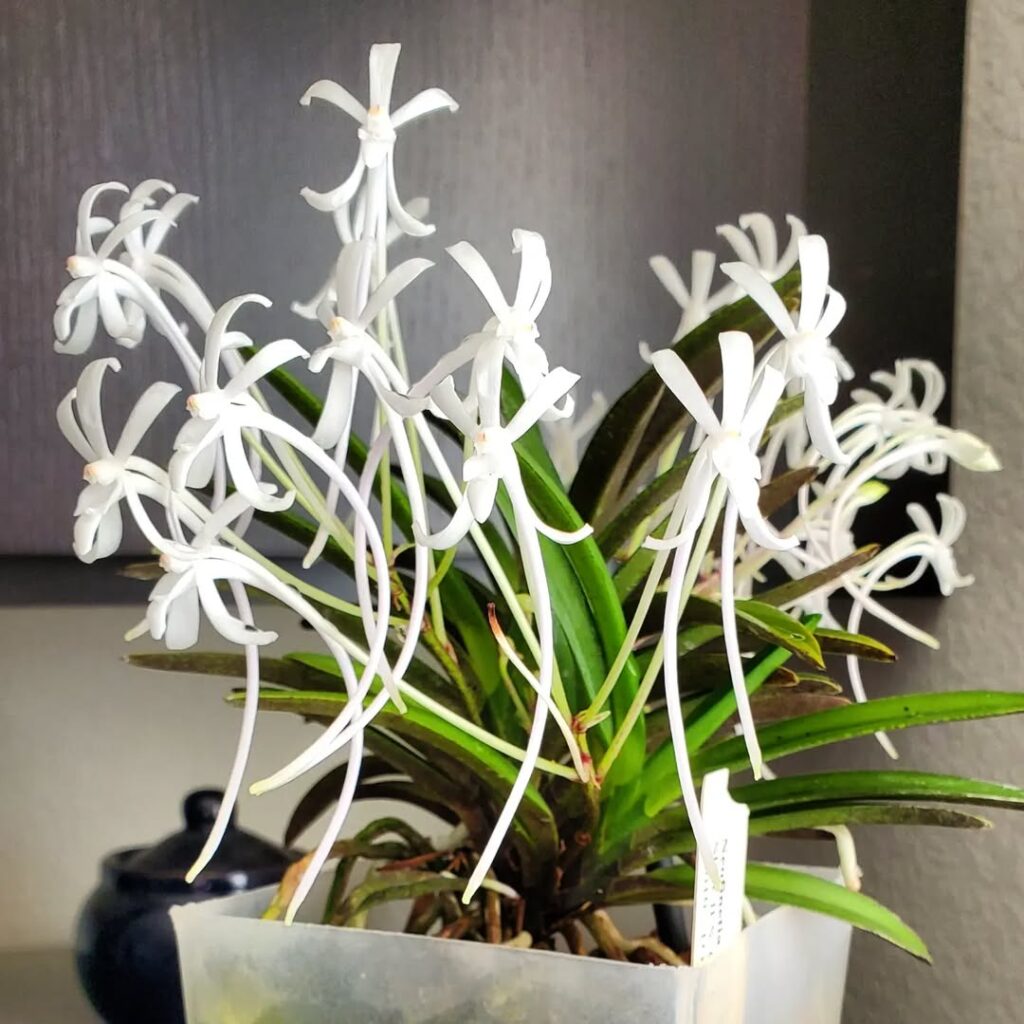
Known as the Samurai Orchid in Japan, it produces fragrant, delicate white flowers.
Holy Ghost Orchid (Peristeria elata)
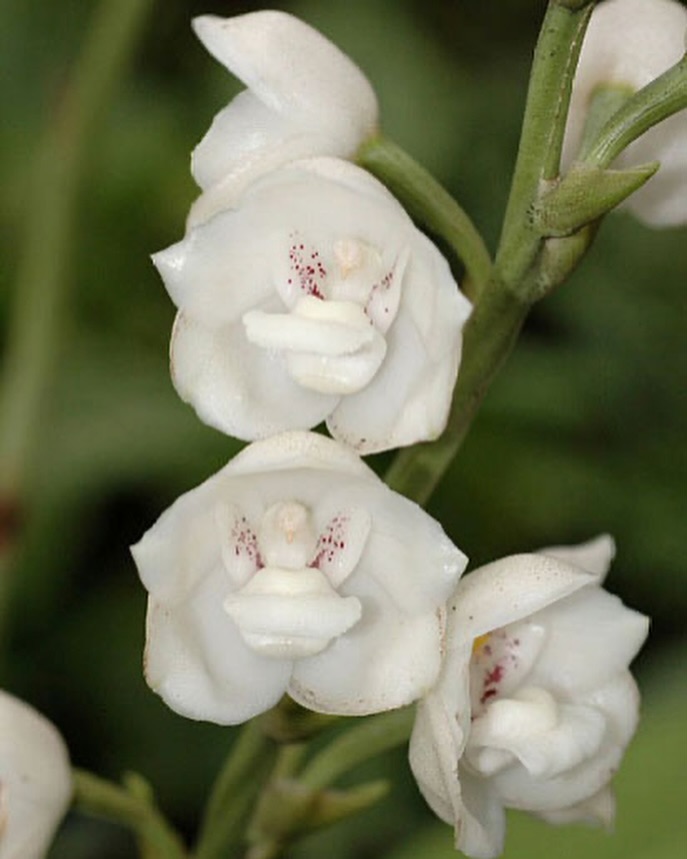
Features large, ethereal white blooms with a “dove” shape at its center—a symbol of peace.
White Fringeless Orchid (Platanthera integrilabia)
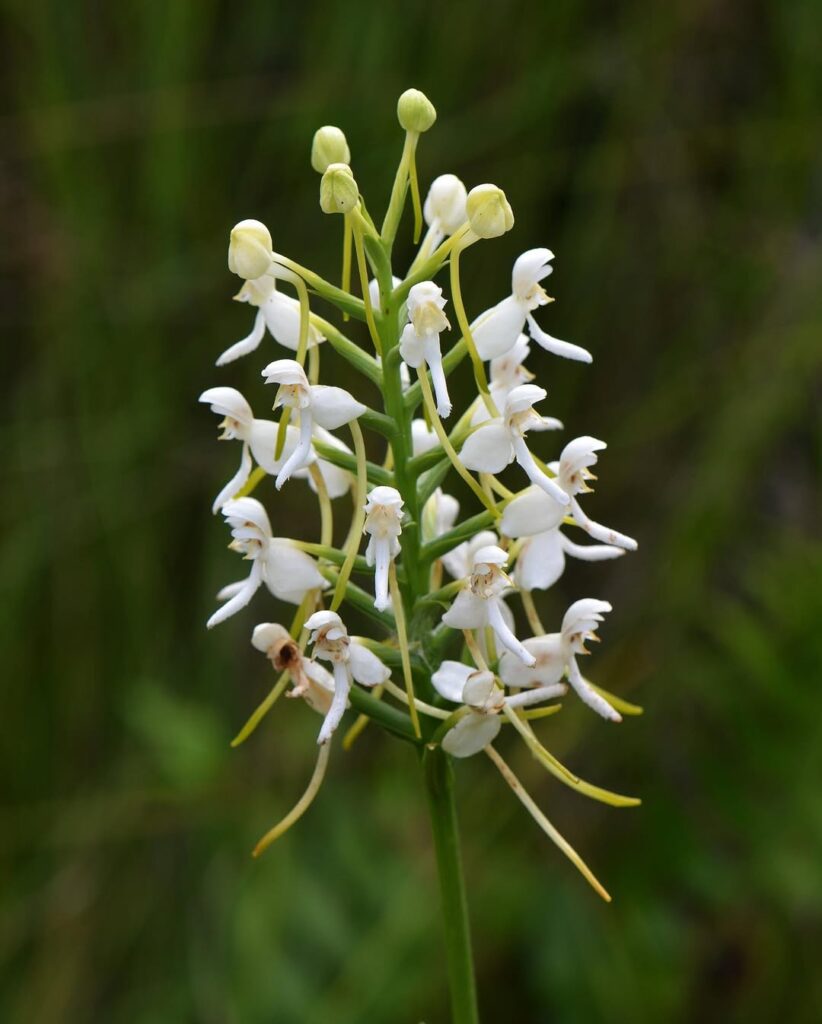
This rare orchid has pure white petals and thrives in wetlands.
Christmas Orchid (Cattleya trianae)
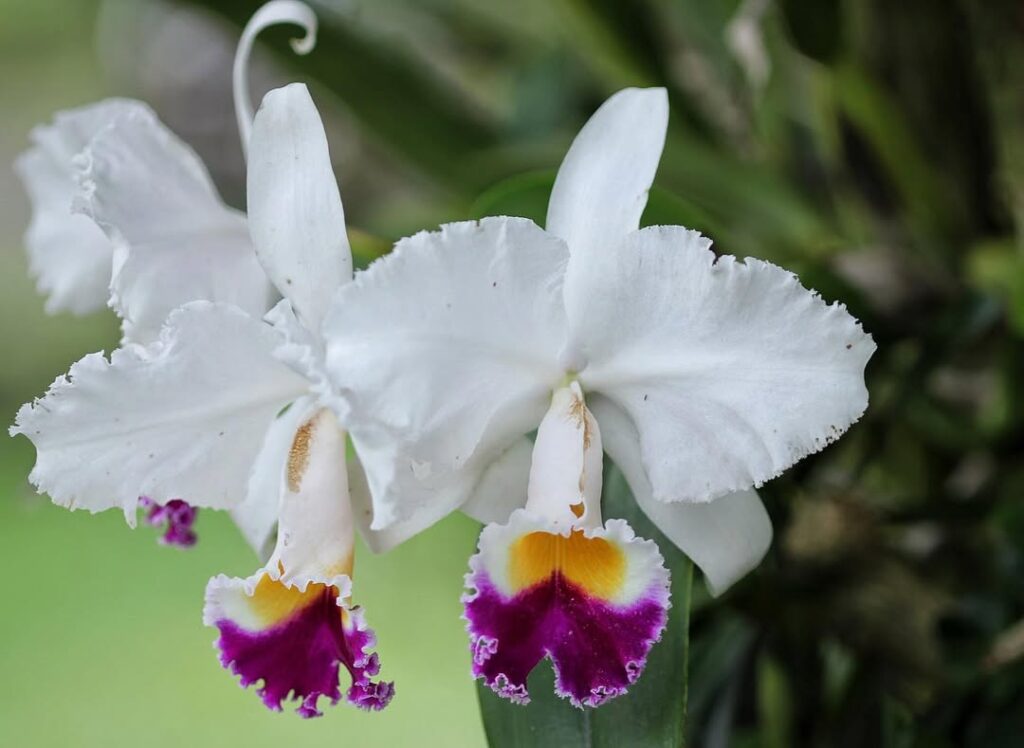
Known for its snowy white blooms that brighten up the festive season.
Greater Butterfly Orchid (Platanthera chlorantha)
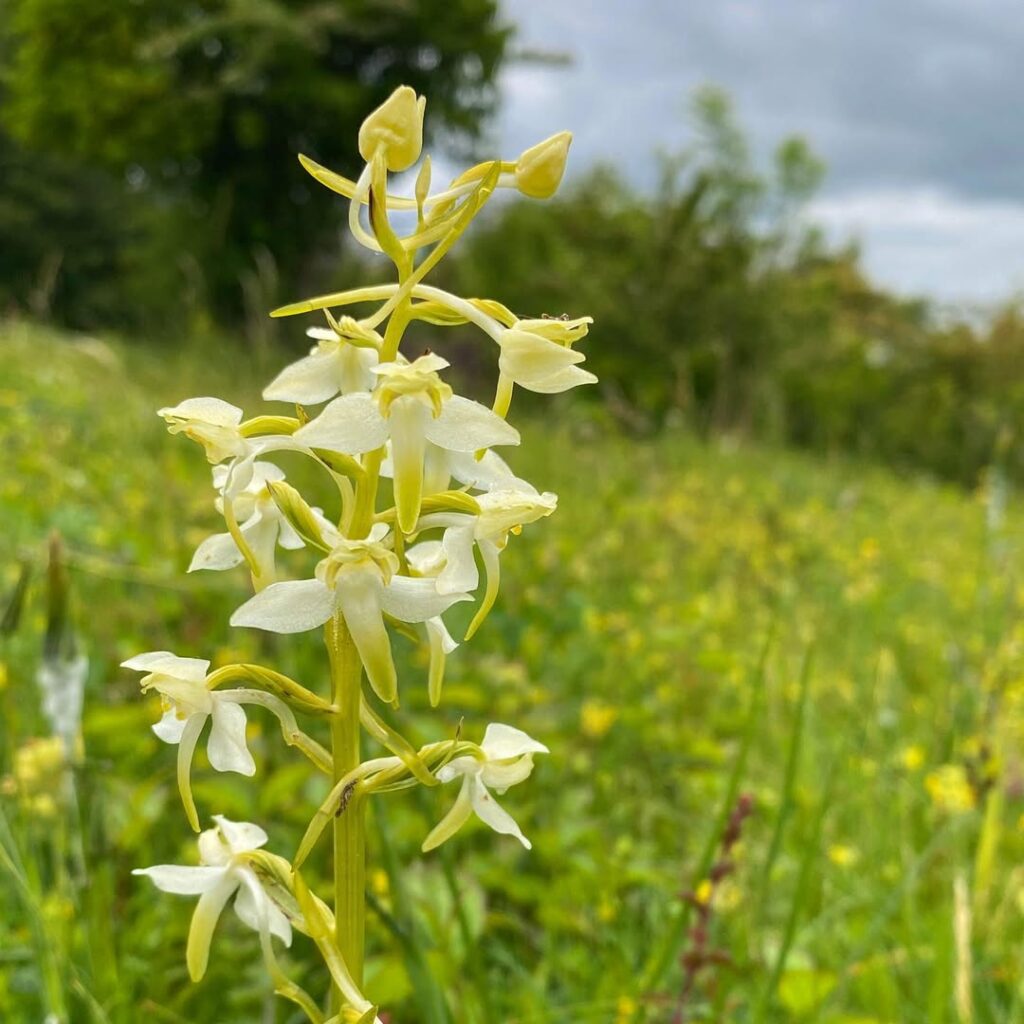
A charming woodland orchid with graceful, butterfly-like white flowers.
Great Plains White Fringed Orchid (Platanthera praeclara)
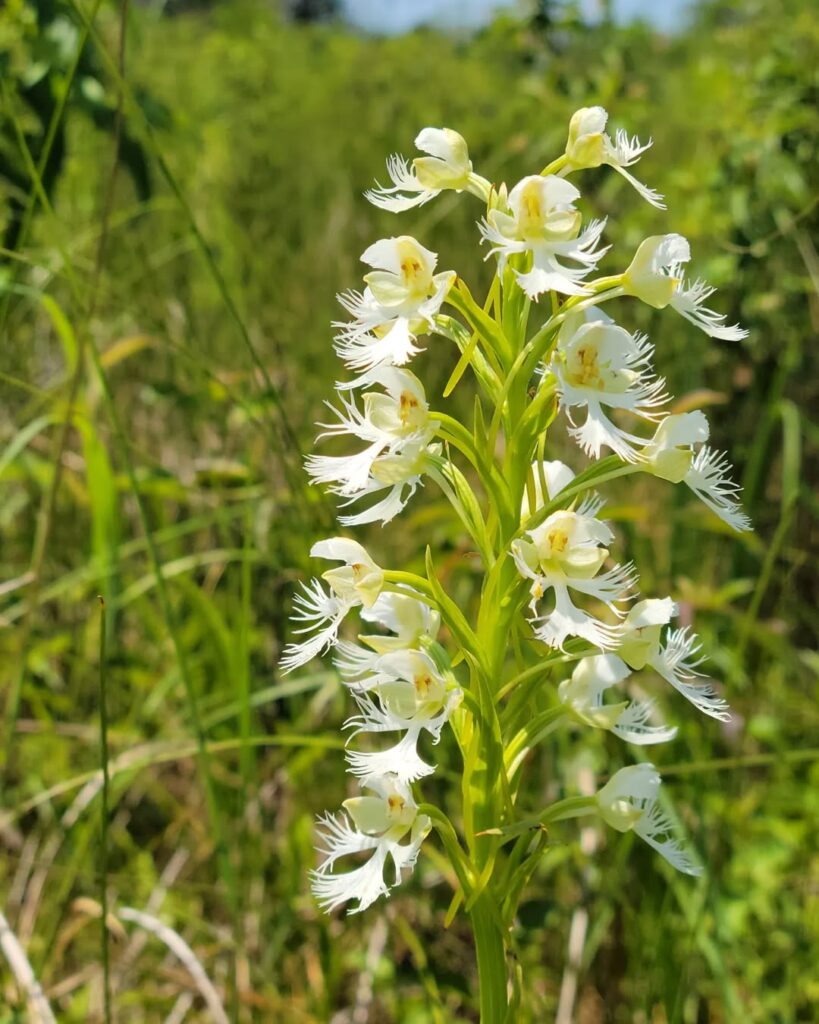
A rare species with intricate white flowers found in prairies.
Eastern Prairie Fringed Orchid (Platanthera leucophaea)
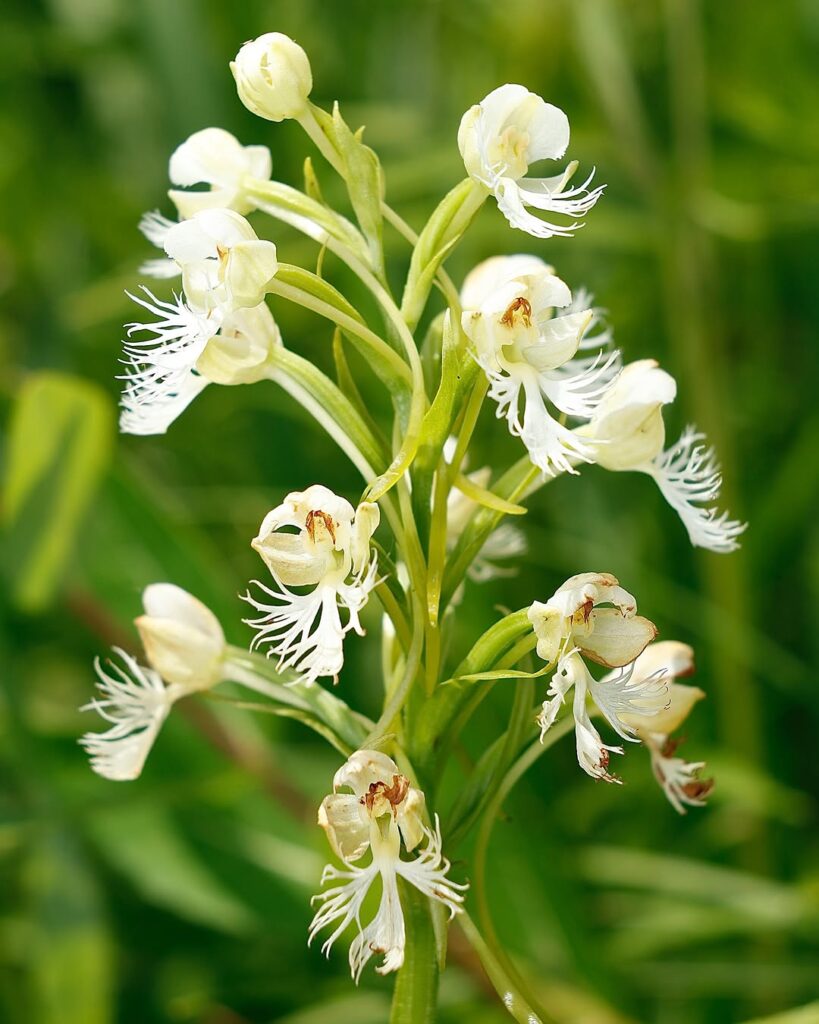
A tall orchid with fringed, spidery white blooms that thrive in grassy landscapes.
Bog Candle (Platanthera dilatata)

This delicate white orchid brightens boggy areas with its subtle charm.
Snowdrop Orchid (Dendrobium infundibulum)
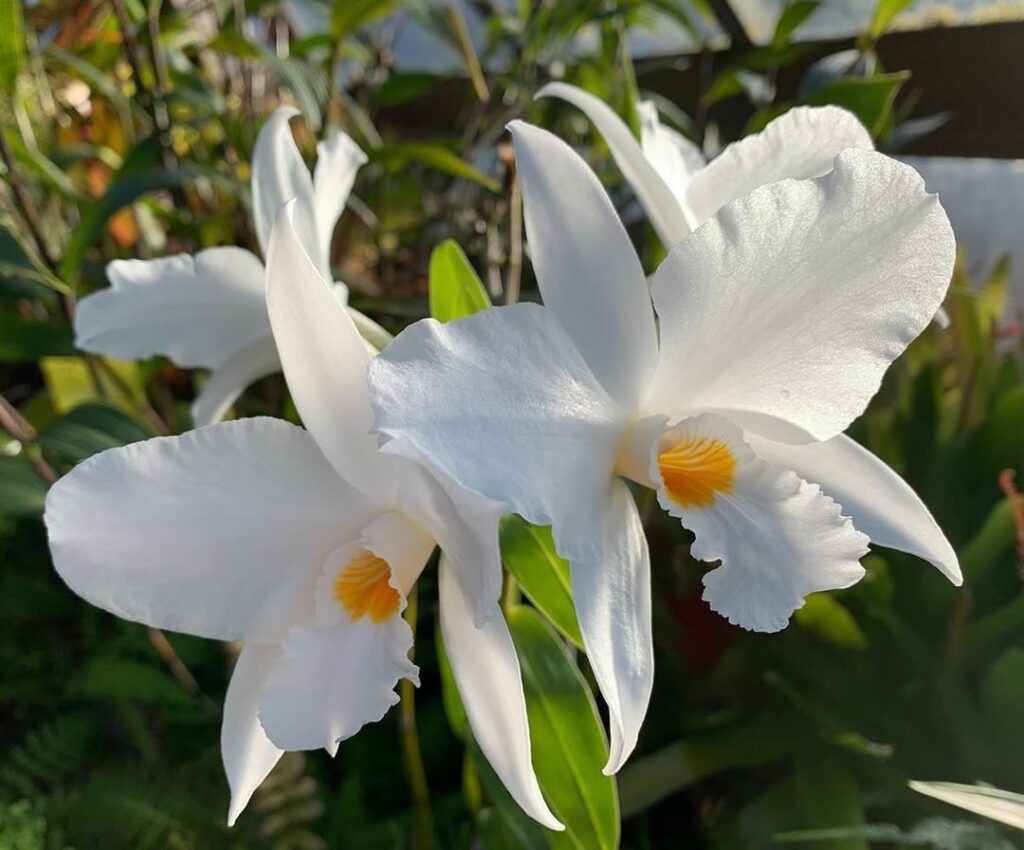
A striking orchid with pristine white flowers and a subtle yellow center.
White Spider Orchid (Caladenia longicauda)
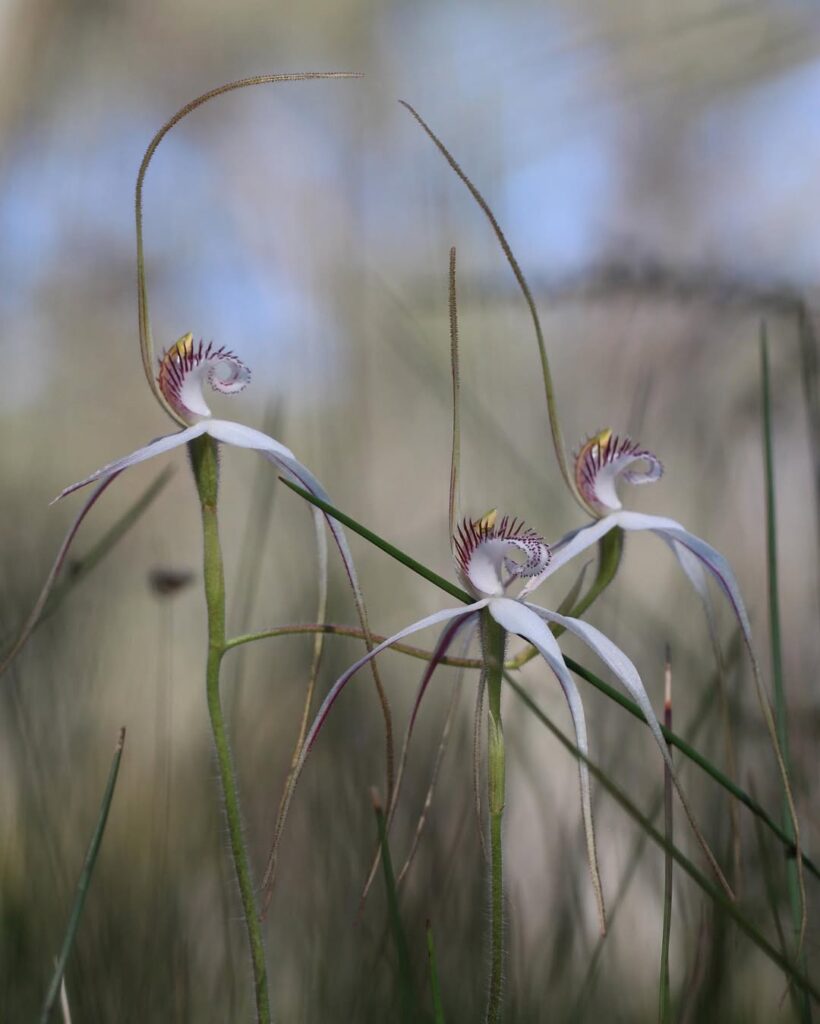
An Australian native with spidery white blooms and long, narrow petals.
White Lady Orchid (Caladenia catenata)
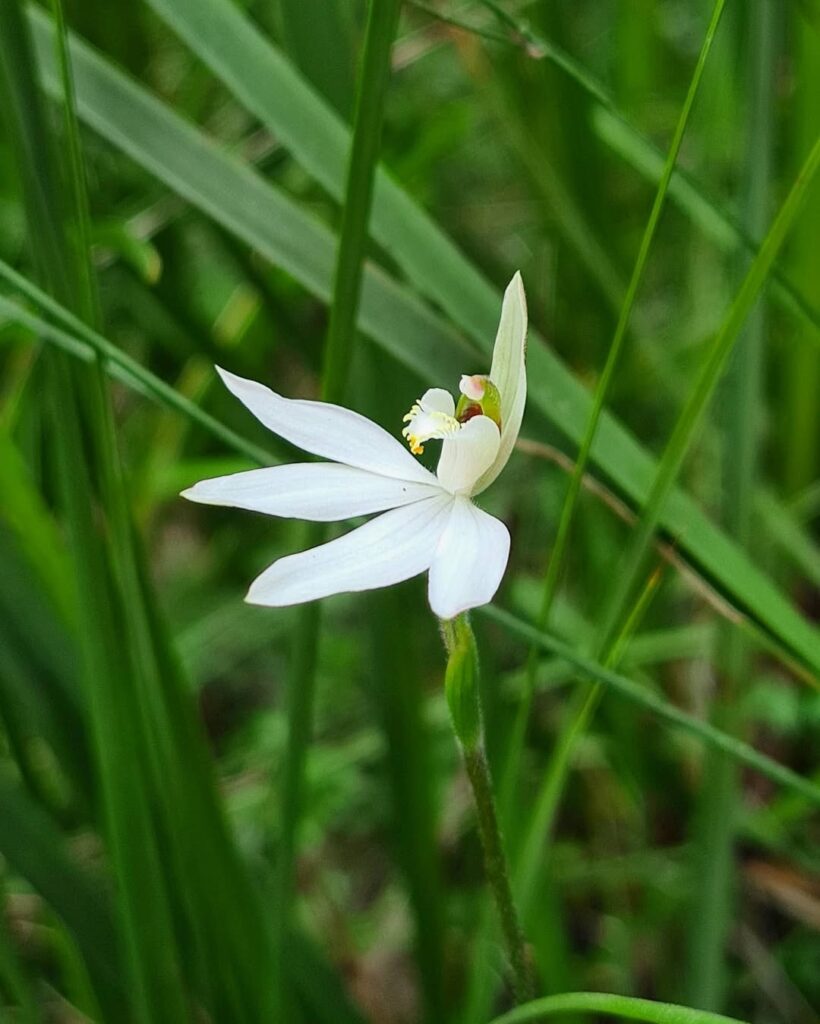
A dainty species with a single, elegant white flower and slender stem.
White Jewel Orchid (Ludisia discolor alba)
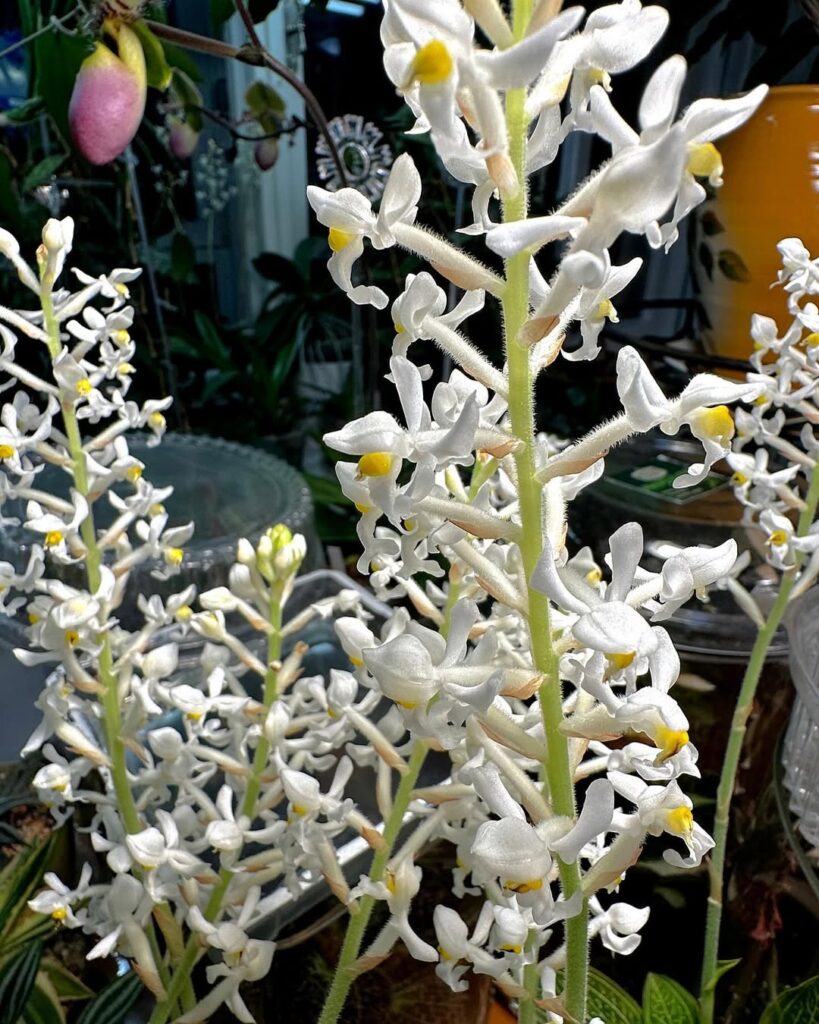
A rare variant of the Jewel Orchid, prized for its velvety white flowers and unique foliage.
White Butterfly Orchid (Platanthera bifolia)
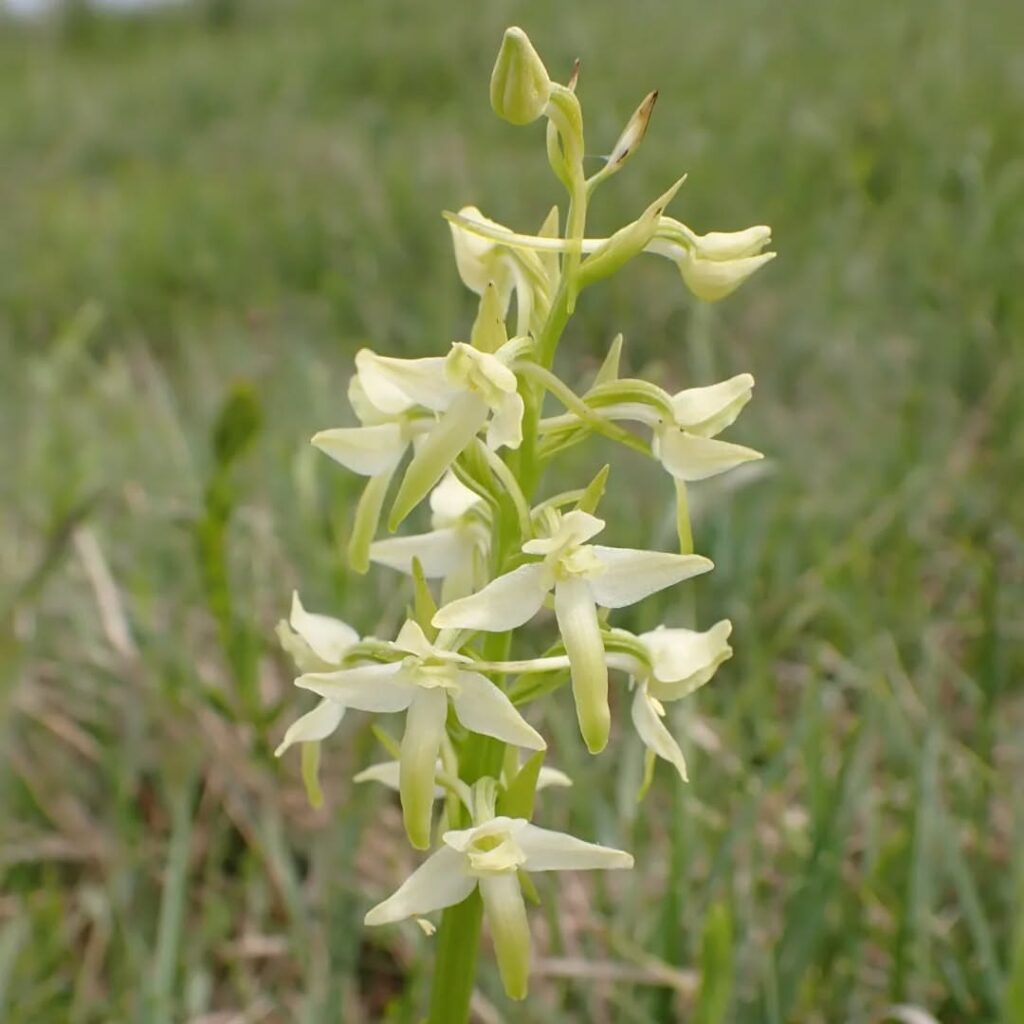
Named for its fluttery, butterfly-like white flowers, often found in meadows.
White Slipper Orchid (Paphiopedilum niveum)
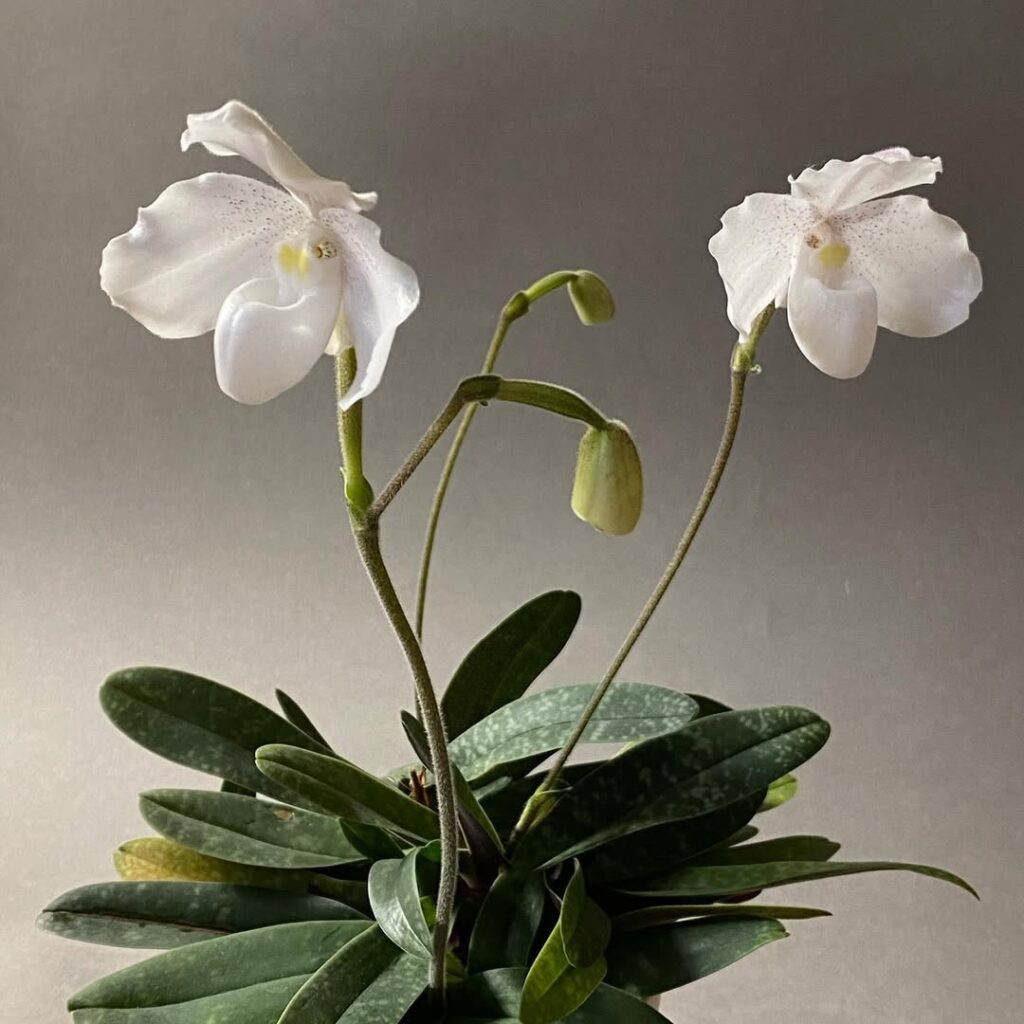
This compact orchid features a pure white “slipper” bloom with a waxy texture.
White Bog Orchid (Platanthera leucostachys)
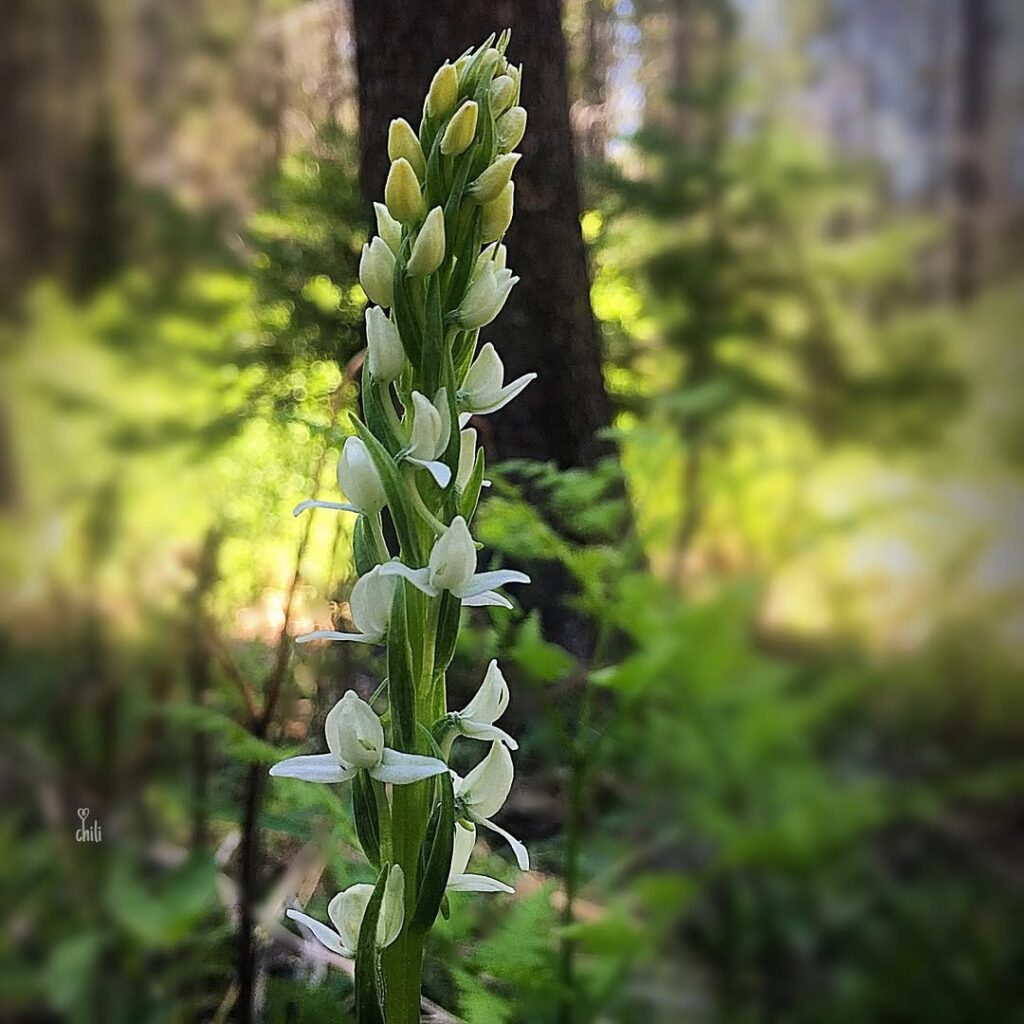
A tall, wild orchid with spikes of small, delicate white flowers.
White Swamp Orchid (Phaius tankervilleae alba)
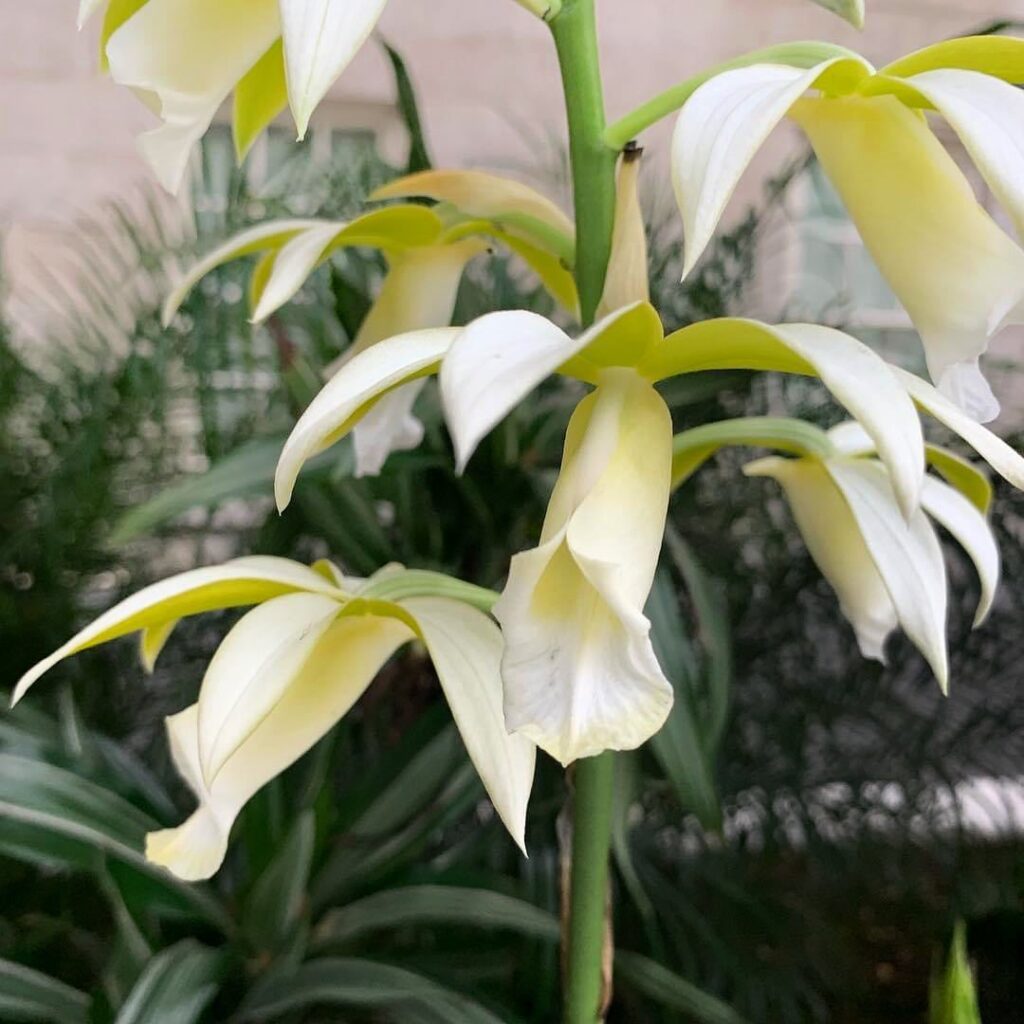
A tropical orchid with striking white blooms and tall, imposing stems.
White Rain Orchid (Cymbidium eburneum)
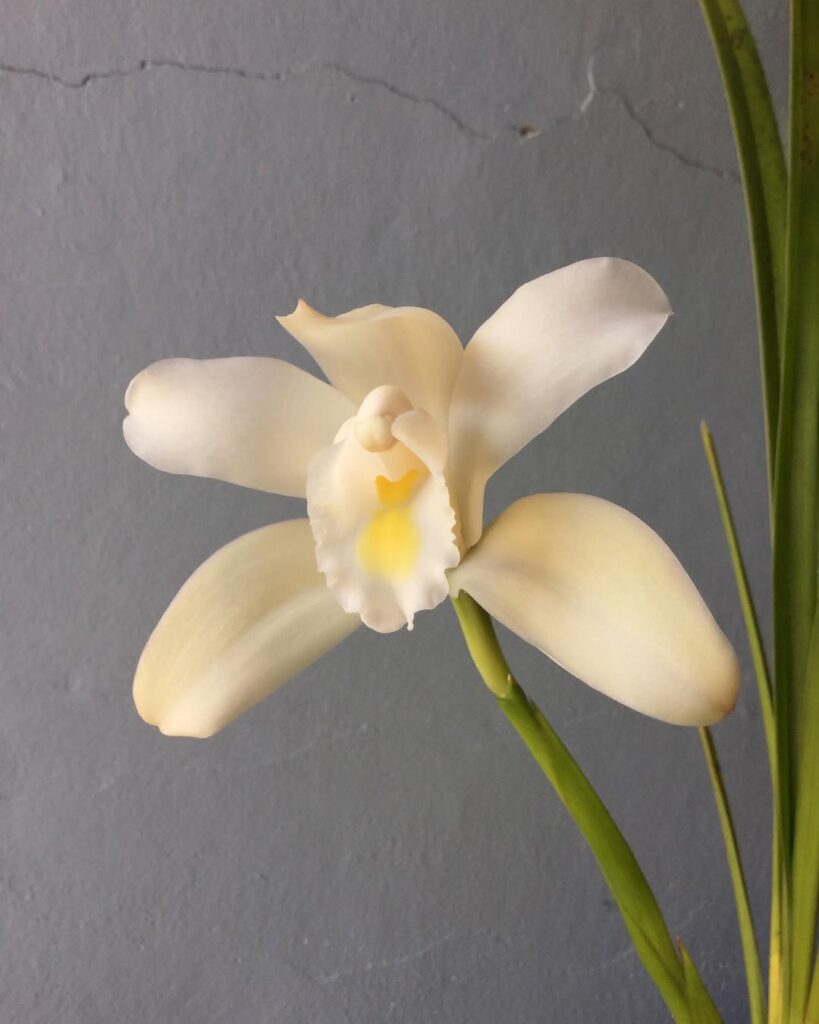
Renowned for its creamy white flowers and subtle citrusy fragrance.
White Star Orchid (Angraecum sesquipedale)
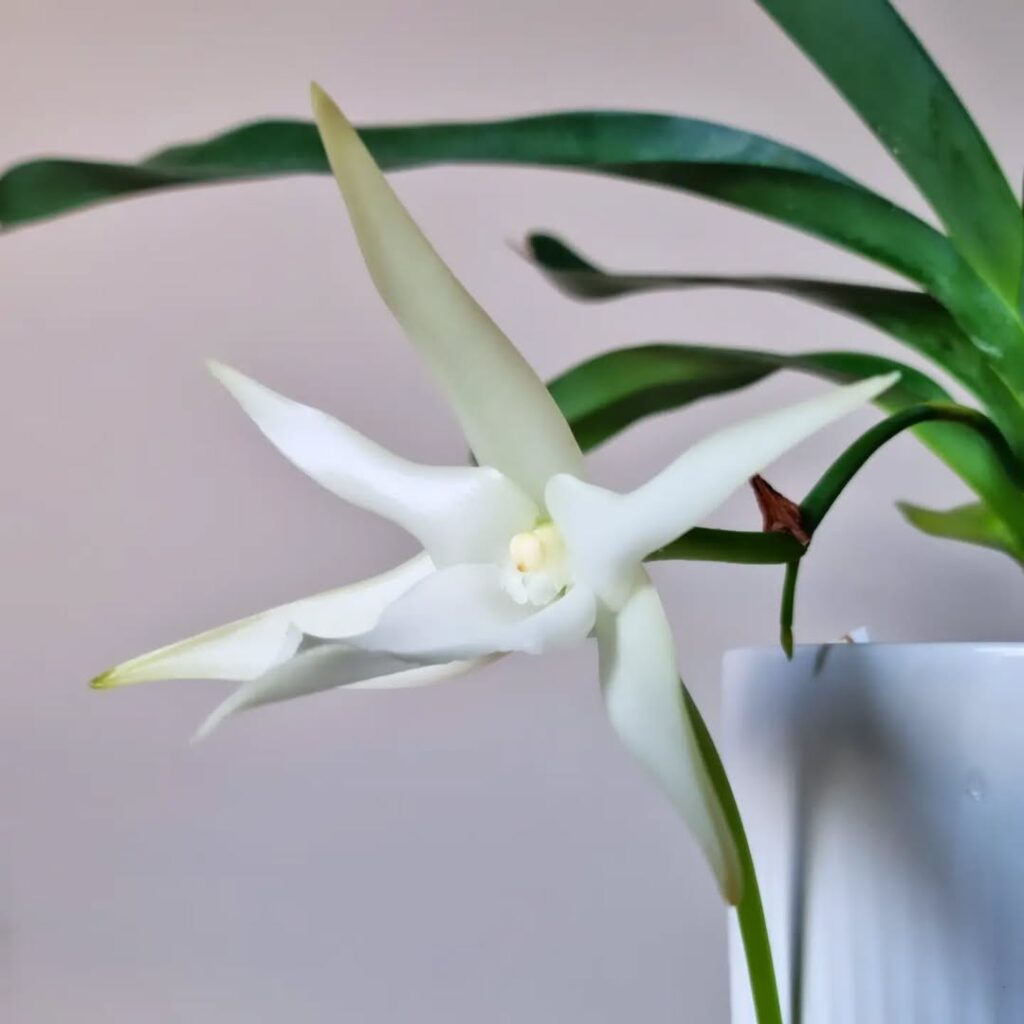
Famous for its star-shaped blooms and long nectar spur, epitomizing elegance.
Essential Growing Conditions for White Orchids
Although white orchids can adapt to various environments, they thrive best under specific conditions that mirror their natural tropical habitat. You’ll need to maintain temperatures between 65-80°F during the day and 60-65°F at night.
Light exposure is essential, but don’t place them in direct sunlight. Instead, position your orchids near an east-facing window where they’ll receive bright, filtered light. Humidity should stay between 40-70%, which you can achieve using a humidity tray or small humidifier.
For best growth, use a well-draining orchid potting mix and water thoroughly when the top inch of medium feels dry. Don’t forget to provide good air circulation to prevent fungal issues.
Watering and Feeding Your White Orchids
Watering your white orchids correctly means following a “soak and dry” method, where you’ll thoroughly drench the roots every 7-10 days and let them nearly dry between waterings. You’ll need to feed your orchids with a balanced 20-20-20 fertilizer, diluted to quarter-strength, every other watering during the growing season. When it comes to timing, you should water in the morning hours, allowing excess moisture to evaporate before nightfall to prevent root rot and fungal issues.
Proper Watering Schedule Tips
Since white orchids thrive on a consistent watering routine, you’ll need to establish a reliable schedule that matches their natural growth cycle. Water thoroughly once every 7-10 days during active growth, and reduce to every 14 days during dormancy.
Check moisture levels by inserting your finger one inch into the potting medium – if it’s dry, it’s time to water. During morning hours, water until it flows freely from drainage holes, then allow the pot to drain completely for 15 minutes.
In winter months, adjust your schedule according to humidity levels. If your home’s relative humidity drops below 40%, consider misting between waterings.
Essential Nutrients for Growth
To maintain vibrant white orchids, you’ll need more than just water – proper nutrients play an essential role in their growth cycle. A balanced fertilizer with an NPK ratio of 20-20-20 will provide the nitrogen, phosphorus, and potassium your orchids need to thrive.
During the growing season, apply a quarter-strength fertilizer solution every two weeks. You’ll want to reduce this to monthly applications during winter dormancy. If you’re using bark-based potting media, supplement with magnesium and calcium every third feeding.
Remember to flush the growing medium with plain water monthly to prevent salt buildup, which can damage your orchid’s delicate root system.
Creative Ways to Display White Orchids in Your Home
Your white orchids can transform any room with thoughtful placement and creative display options. For a sleek, contemporary look, try arranging single stems at varying heights on floating wall shelves, keeping 8-10 inches between each plant to create visual breathing room. If you’re working with limited surface space, consider suspending clear glass orbs at different levels, filled with just enough water to support your orchid’s roots while creating an ethereal, floating garden effect.
Modern Minimalist Shelf Arrangements
When designing modern minimalist shelf displays, white orchids excel as striking focal points against clean, uncluttered backdrops. Position your orchid on a floating shelf 48-60 inches from the floor, allowing at least 24 inches of vertical clearance for flower spikes.
Choose sleek, monochromatic containers in white, black, or clear glass that measure no more than 1.5 times the width of your orchid’s root mass. You’ll want to maintain 12-18 inches of empty space around each plant to preserve the minimalist aesthetic.
Pair your orchid with no more than two complementary items, such as a small art piece or geometric sculpture, keeping the arrangement asymmetrical but balanced.
Floating Glass Container Displays
Floating glass containers transform white orchids into ethereal art pieces that appear to defy gravity. You’ll need a cylindrical glass vessel at least 8 inches tall, clear fishing line, and waterproof adhesive to create this stunning display.
Start by securing your orchid’s roots with a small, clear plastic anchor, then suspend it from the container’s rim using fishing line. Position the plant so it hovers 2-3 inches above the water level. Add polished river stones at the bottom for stability and visual appeal.
Remember to change the water weekly and mist the aerial roots every 3-4 days to maintain proper humidity levels.
Mixed Height Grouping Ideas
Three distinct heights create visual intrigue when grouping white orchids together for maximum impact. Position your tallest orchid (24-30 inches) in the back, a medium-height plant (15-20 inches) in the middle, and your shortest bloomer (8-12 inches) in front. This creates a natural “stairstep” effect.
You’ll want to space them 6-8 inches apart, allowing each orchid’s flowers to be visible without overlapping. Consider using decorative risers or sturdy books to achieve perfect height variations. Mix Phalaenopsis varieties with different bloom sizes for added interest, but keep all flowers pure white to maintain a cohesive look.
Common Problems and Troubleshooting Tips
Although white orchids are generally hardy plants, they can face several challenges that affect their health and blooming cycles. You’ll spot trouble when leaves yellow, roots turn mushy, or buds drop before opening.
If your orchid’s leaves wrinkle, you’re likely underwatering. Give it a 15-minute soak once weekly. For black spots, immediately trim affected areas with sterilized scissors and reduce watering. Root rot often starts when water sits in the crown – fix this by blotting excess moisture with paper towels.
Watch for mealybugs, those cotton-like pests. Remove them using a cotton swab dipped in 70% isopropyl alcohol, treating weekly until they’re gone.
Seasonal Care and Maintenance Schedule
Since white orchids require different care throughout the year, establishing a seasonal maintenance routine keeps them thriving. During spring and summer, water your orchid weekly, fertilize monthly with a 20-20-20 solution, and maintain temperatures between 65-80°F.
In fall, reduce watering to every 10 days and stop fertilizing. As winter approaches, you’ll need to adjust for dormancy by cutting back watering to bi-weekly. Keep humidity at 50-70% using a pebble tray or humidifier.
Check your plant’s roots every season, repotting in fresh orchid mix if they’re overcrowded or the medium has broken down. Remember to trim spent blooms year-round.
